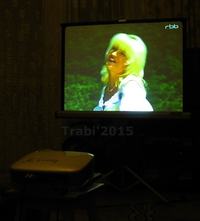Hello! I have a question about what material is used to make screens for projectors/projectors? Has anyone made such a screen themselves? What are the results?

Czy wolisz polską wersję strony elektroda?
Nie, dziękuję Przekieruj mnie tam .
.
raptor3m wrote:.no matter the spheres
_jta_ wrote:There is no way around the "left" projector light - if the screen reflects less, both the "left" and the right one giving the image - the contrast remains the same....
_jta_ wrote:The ball screen only reduces (and greatly) the impact of extraneous light coming from decidedly different directions.
_jta_ wrote:The result will only be lower brightness, contrast will not be increased.... How about putting a weaker lamp in the projector instead? The result will be the same...
_jta_ wrote:There could still be this solution: a projector behind the screen, the screen does not reflect the light, it lets it through and directs it at the audience.
_jta_ wrote:Where is this "left" light coming from? Or, instead of combining with a grey screen, would it be simpler to cover up this "left" light?
If it is coming from the projector lamp, then reducing its brightness will deepen the black just as much as using a grey screen. And turning it off will give a perfect one.
raptor3m wrote:.light comes in sideways - unfortunately, this cannot be eliminated by dimming the lamp
_jta_ wrote:But if that light is coming out sideways, then some sort of shielding should help. In cinemas, I think they have a separate projector room, with an opening from it through which this proper light comes out, and this "left" light largely misses the opening and is absorbed (there are probably some black curtains hung in this room). A question of geometry.
ladamaniac wrote:Now you can buy projection screen paints, price 300-500 zloty per litre.
